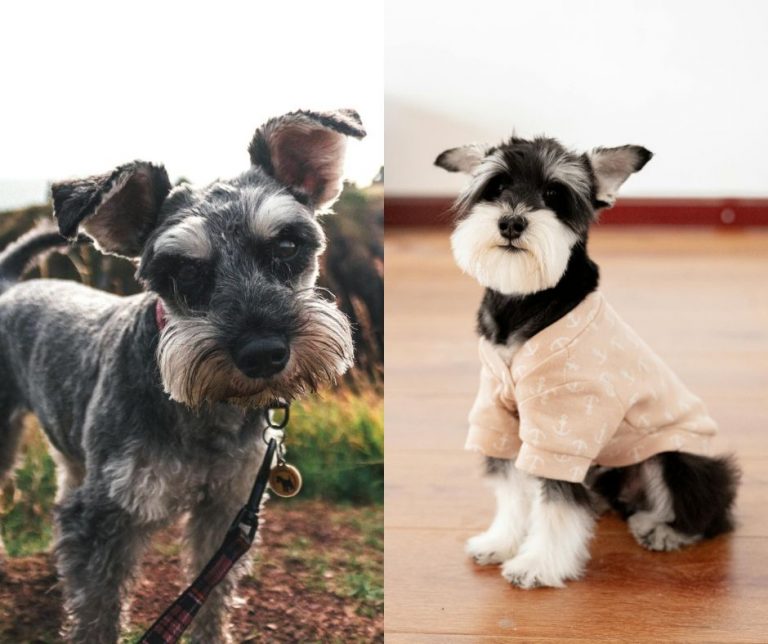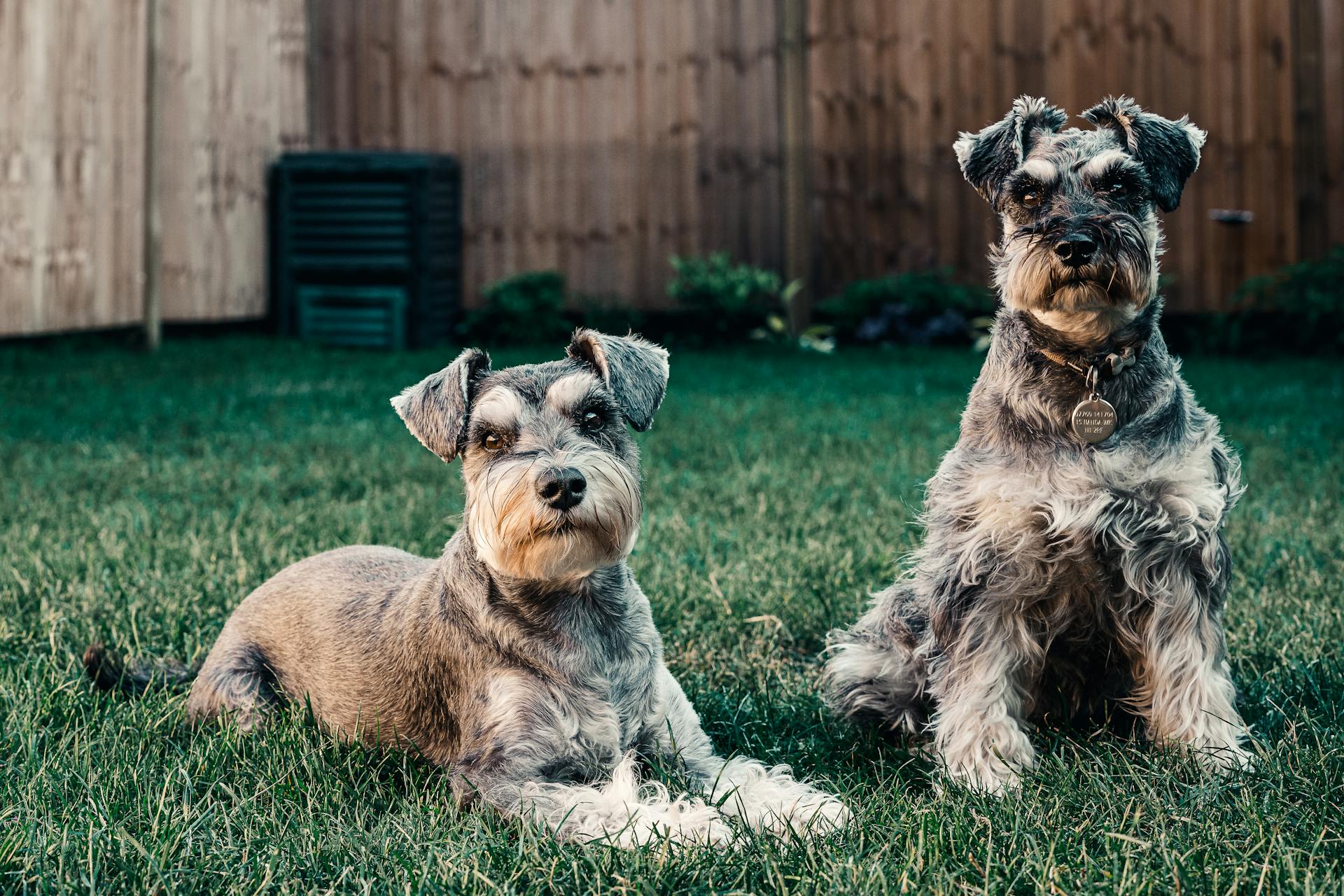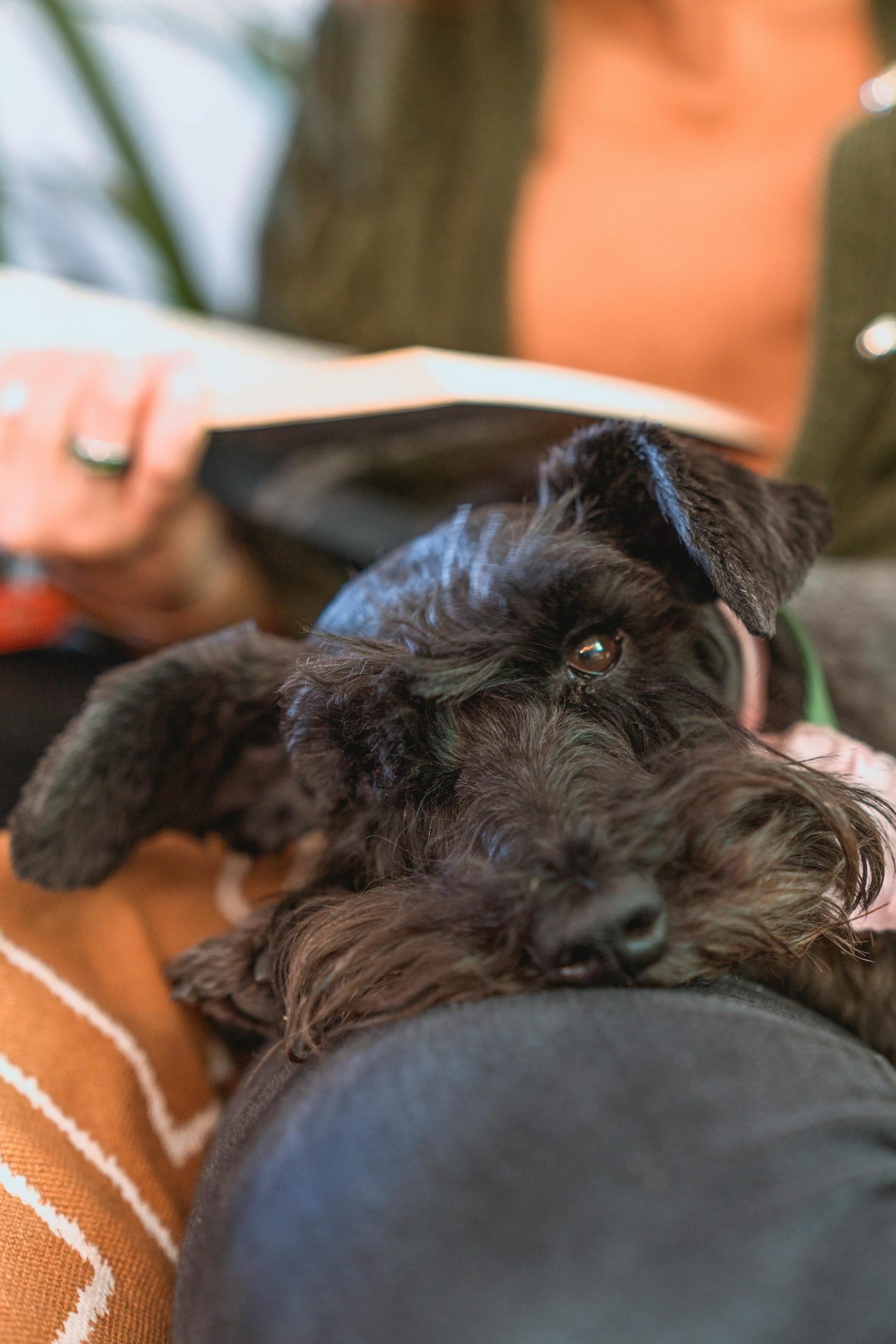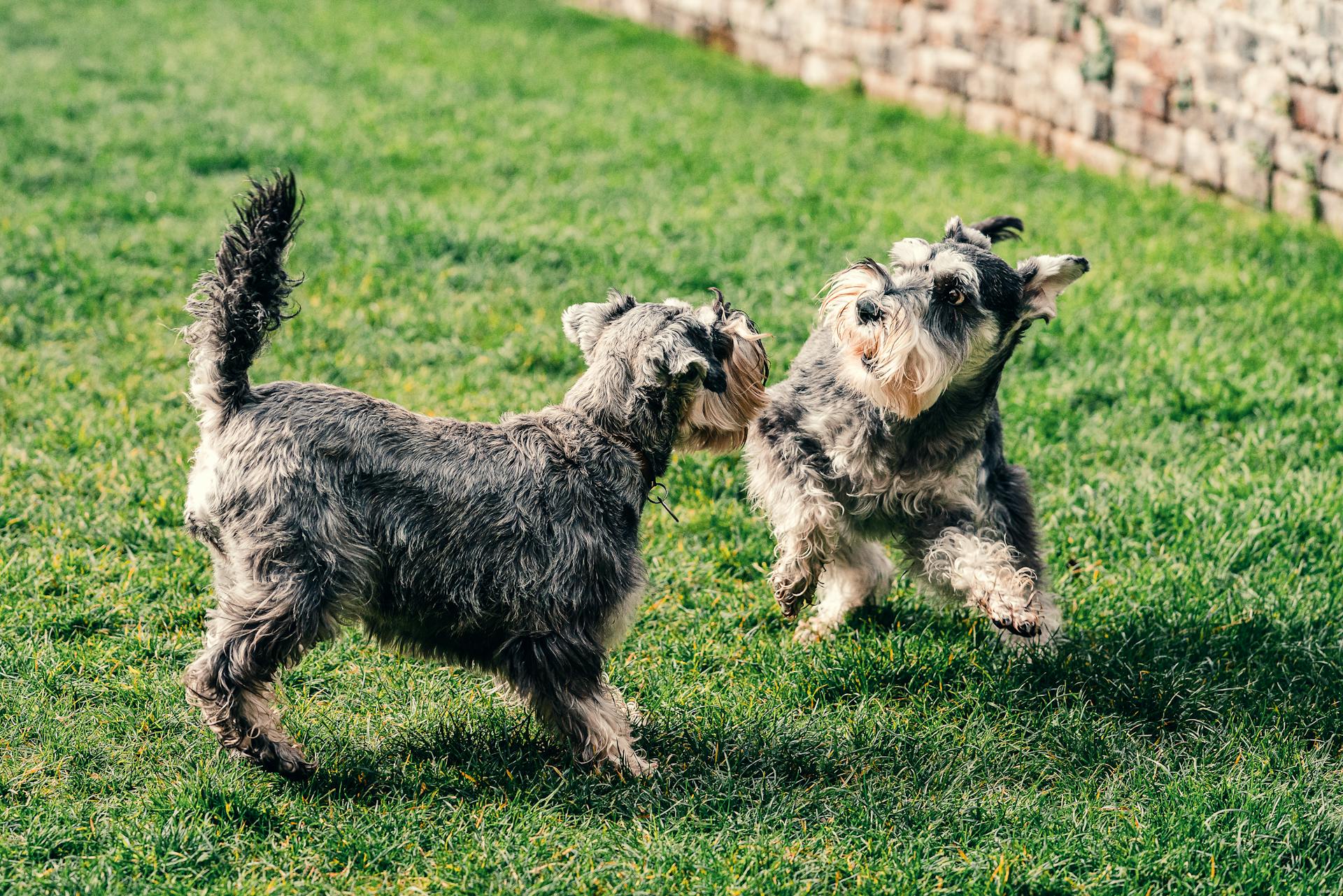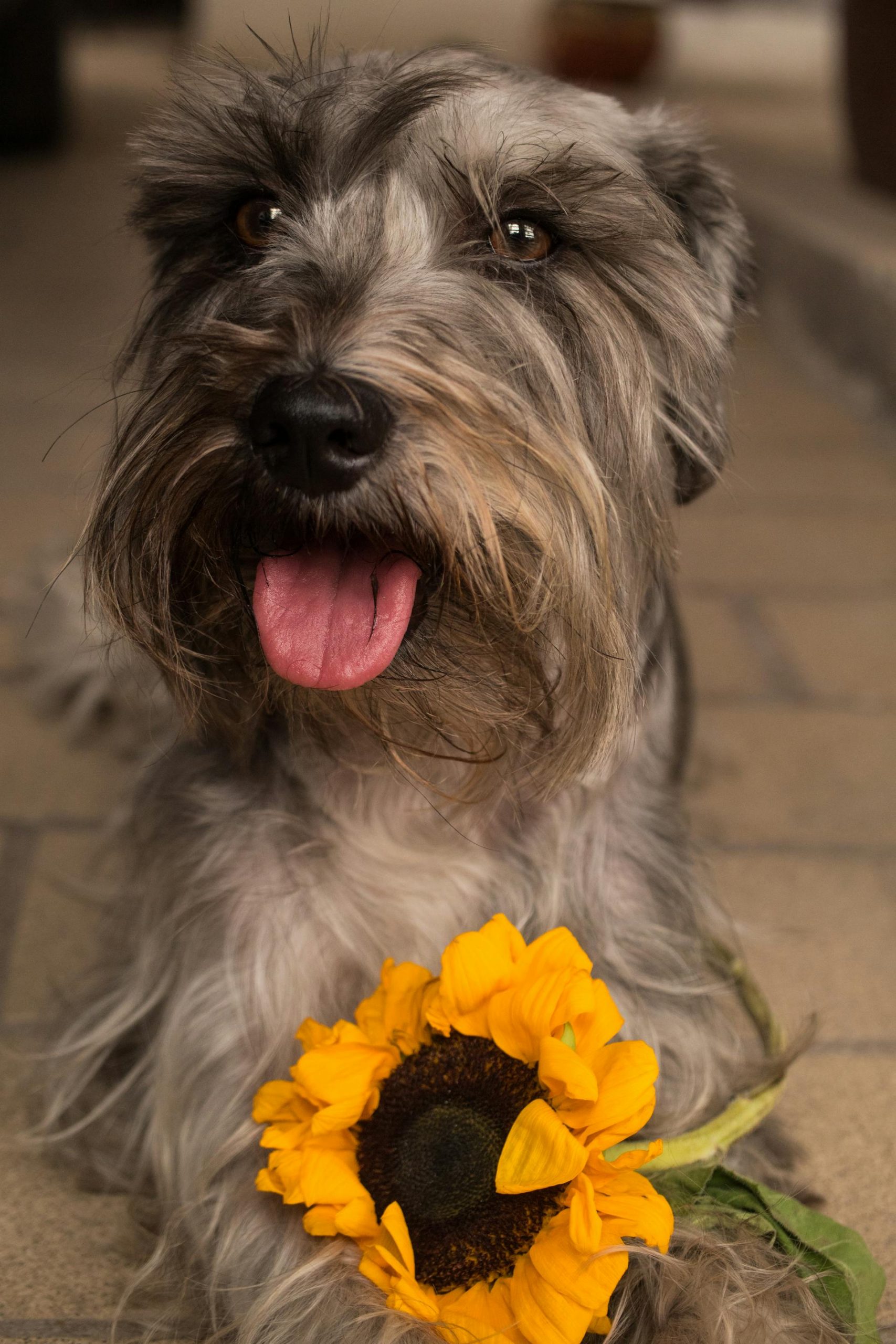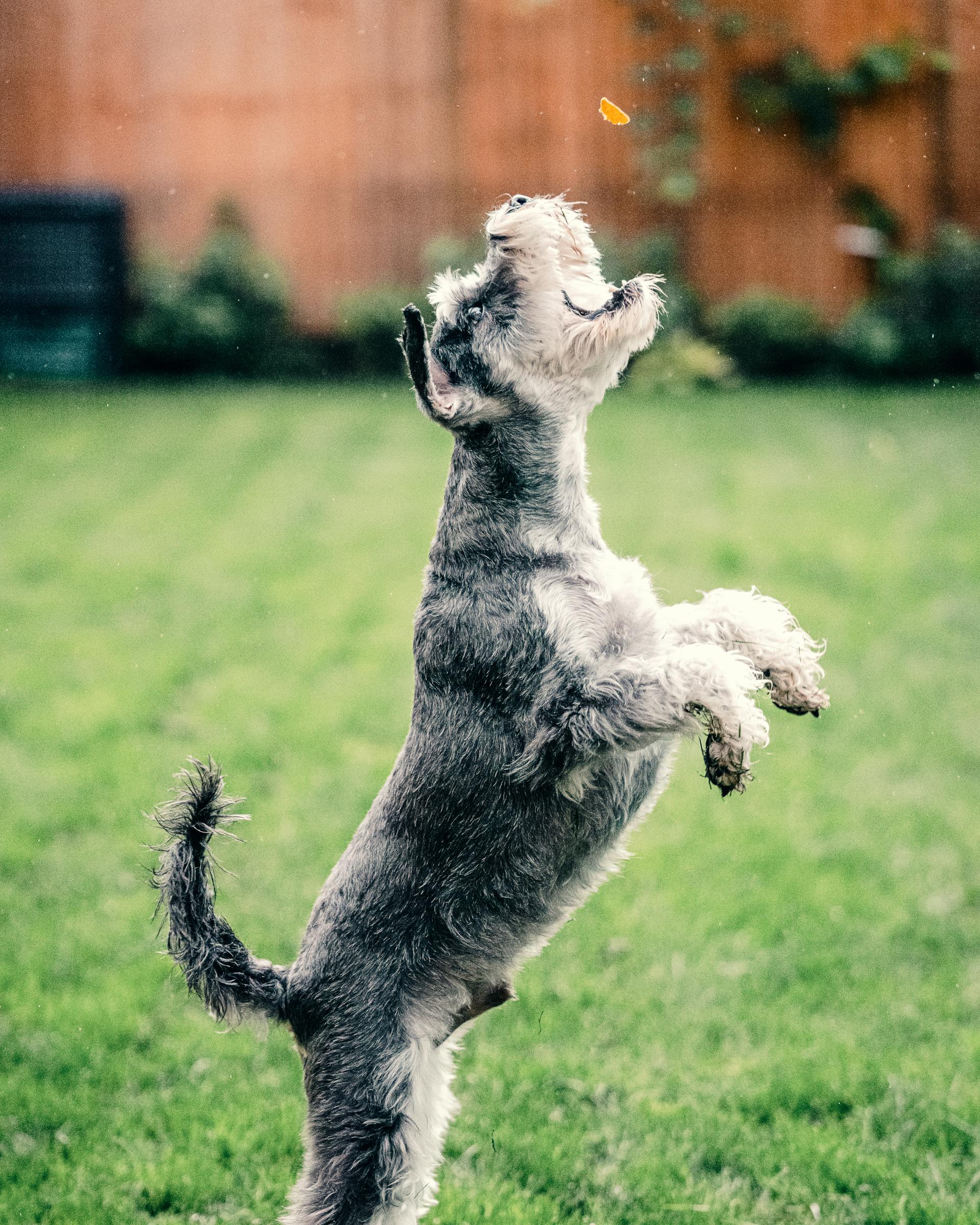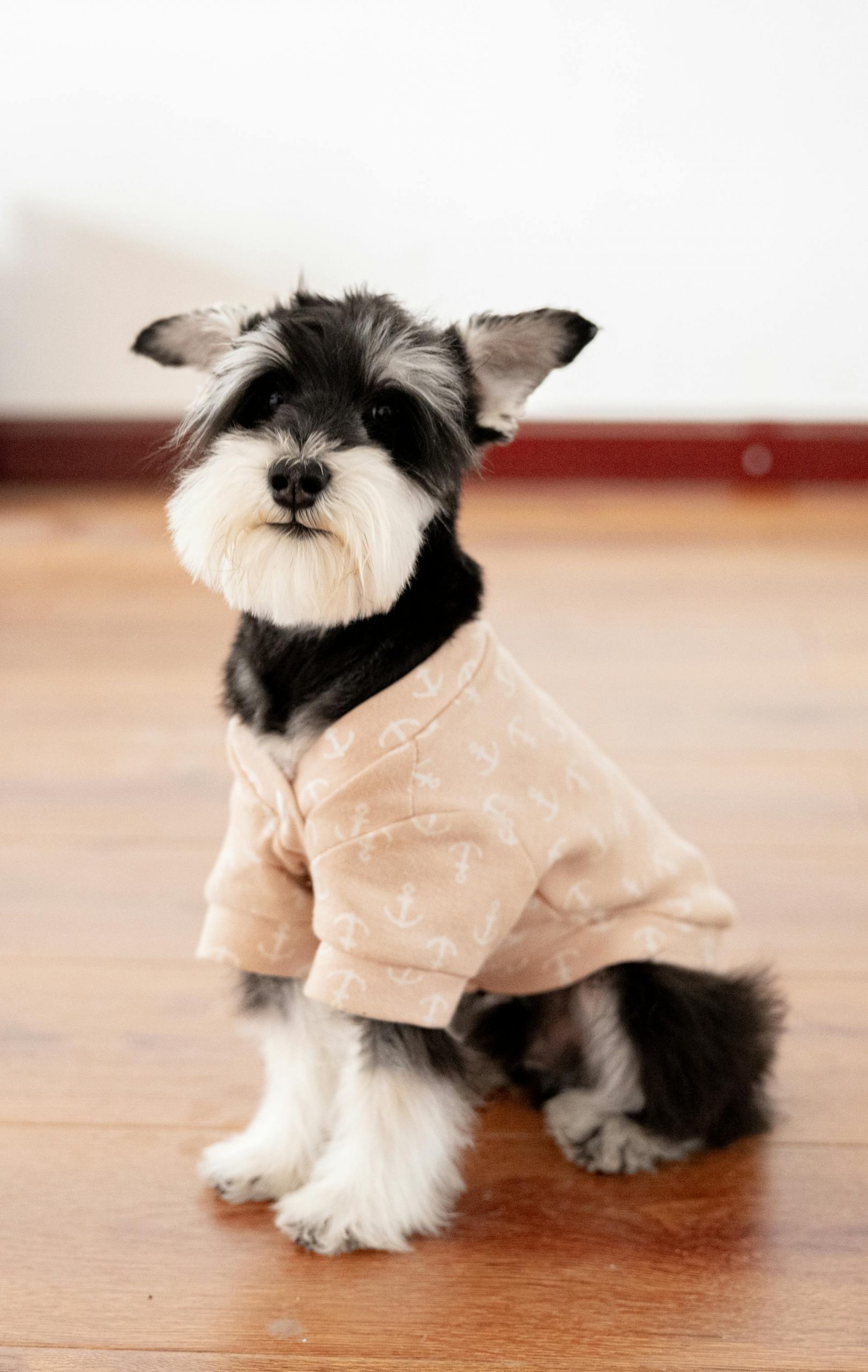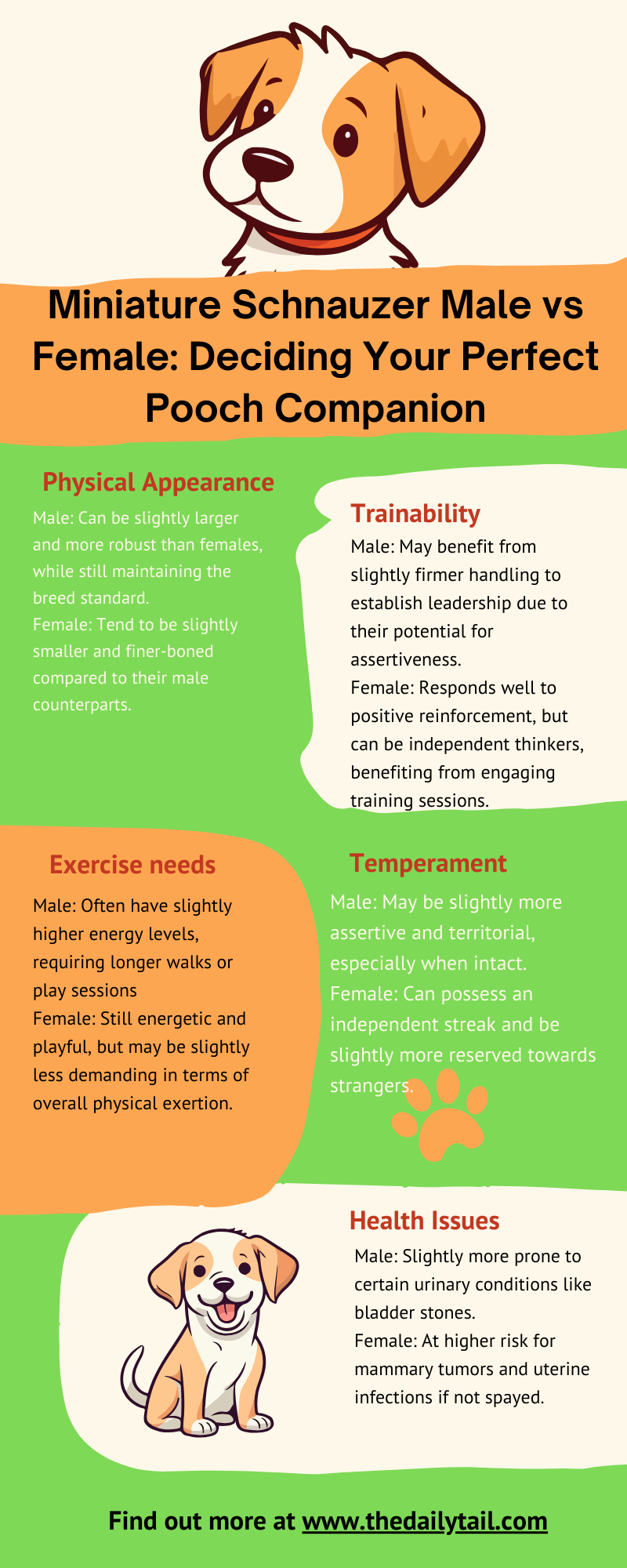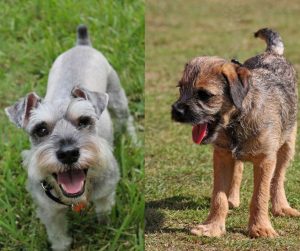Are you team male or team female when it comes to Miniature Schnauzers? There’s more to consider than just their adorable beards! As an experienced dog owner, I can tell you there is a difference between owning a male dog and a female dog. After years of living with dogs, I can help guide you to the right decision.
When considering the addition of a Miniature Schnauzer to the family, one might wonder if gender plays a significant role in their future pet’s personality, compatibility, and care. Common among Miniature Schnauzers – regardless of gender – are their intelligence, loyalty, and affectionate nature, making them wonderful companions. However, some nuanced differences between male dogs and female dogs can influence the decision-making process.
These differences span from their physical characteristics to their behavioral traits, which can be informed by a blend of genetic predispositions and individual personality.
Male Miniature Schnauzers often display a larger, more muscular build compared to their female counterparts, which may affect their presence and space requirements. From a behavioral standpoint, males can exhibit more territorial and independent tendencies, which could influence training and socialization strategies.
Females, traditionally, are thought to be quicker to housebreak and might show a propensity for more affectionate behavior, possibly making them more suitable for certain home environments. So, let’s take a look at the Miniature Schnauzer male vs female dog comparison.
Key Takeaways
- Male and female Miniature Schnauzers both share intelligent and affectionate traits, yet differ in physical size and behavioral tendencies
- Females may housebreak more quickly, while males often display a larger stature and independent behavior
- Considering gender-specific traits can aid in matching a Miniature Schnauzer’s personality and care needs with the right home
Breed Overview
The Miniature Schnauzer is a small dog breed hailing from Germany, treasured by many for its lively and alert nature. Serving historically as a watchdog on farms, this breed quickly became a cherished companion across the world. They display a distinctive appearance, marked by a wiry coat, bushy eyebrows, and an iconic beard.
Characteristics of Miniature Schnauzers:
- Size: Smaller stature as part of the terrier family
- Temperament: Friendly, fearless, and intelligent
- Lifespan: Generally, they live for 12-15 years
When it comes to their role within the family, Miniature Schnauzers are adaptable, eager to please, and bond deeply with their owners.
Whether in an apartment or a house with a yard, these dogs can thrive and become an integral part of one’s home life.
Miniature Schnauzers are often chosen for their size, which makes them suitable for a variety of living situations. They’re as comfortable playing in a spacious backyard as they are curled up on a city dweller’s lap. It is worth noting that according to the American Kennel Club, there are three size variations of the Schnauzer breed. Those are Miniature Schnauzer, Standard Schnauzer, and Giant Schnauzer.
Quick Facts:
- Origin: Germany
- Breed Group: Terrier
- Size: Small
- Role: Companion, Watchdog
Their alertness makes them excellent watchdogs, always keen to let their family know if something is amiss. Despite their small size, these dogs have large personalities, often surprising newcomers with their boldness and spirited character.
Physical Differences
When it comes to male and female Miniature Schnauzers, you might wonder just how different they are beyond their gender. Let’s sharpen our focus and hone in on the specifics, like size, weight, and their distinctive coats.
Size and Weight
Male Miniature Schnauzers typically have a bit more to them when you lift them up. Expect a male Mini Schnauzer to stand about 12 to 14 inches tall at the shoulder. Now, on the scales, they’ll range between a solid 11 to 20 pounds. They have a muscular and strong build that contributes to this weight.
On the flip side, female Miniature Schnauzers might give your arms a bit less of a workout. They usually measure a smidge shorter, from 11 to 13 inches in height. And when she hops on the scale, she’ll likely be between 10 to 15 pounds. Don’t be fooled by her lighter frame, though—she’s still as sturdy and lively as her male counterpart.
That breed standard, set by the American Kennel Club, applies only to the Mini Schnauzer. There are other measurements for the Standard Schnauzer and the Giant Schnauzer.
Coat and Color
Both male and female Miniature Schnauzer dogs sport an impressive double coat that’s wiry on top with a softer undercoat. This isn’t just a fancy suit; it’s practical for fending off rough weather. When you look at them, you might think they’re dressed for a black-tie event every day, with colors typically ranging from solid black, silver, and salt and pepper.
But there’s more to this stylish coat than meets the eye. The coat doesn’t just look good—it helps them adapt to different environments too. And regardless of whether you find a male or female Schnauzer, their fur requires regular grooming to maintain that debonair look they’re known for.
Behavioral Characteristics
When considering male versus female Miniature Schnauzers, it’s important to look closely at their behavioral characteristics. These traits can illuminate how each gender may fit into a family or individual’s lifestyle.
Personality Traits
Male Miniature Schnauzers are often seen as more playful and affable, always eager to be the center of attention. They may seek out affection and interaction more persistently than their female counterparts, who are usually considered more independent in nature.
Females may display alpha traits, setting the social hierarchy within a dog pack, and can be affectionate too, but on their own terms.
Territorial Tendencies
Territorial behavior can be apparent in Miniature Schnauzers, with both genders keen on protecting their home. Males may exhibit more territorial actions, like marking and more frequent alert barking. Females, while still protective, might exhibit this behavior to a lesser degree. However, early and consistent training can mitigate these tendencies in both genders.
Training Response
Miniature Schnauzers are intelligent dogs, able and eager to please, which generally makes training them a rewarding process.
Males might be playful during training sessions, but they respond well to positive reinforcement.
Meanwhile, females, potentially housebroken faster than males, may also have an independent streak that could make specific training tasks a bit more challenging. However, patience and consistency generally lead to good outcomes with both genders.
Being loyal companions, both male and female Schnauzers get along well with their human families and can integrate well into a variety of home environments.
Socialization and Companionship
When choosing a Miniature Schnauzer puppy, it’s essential to consider how they’ll mesh with your family dynamic. They are known for their outgoing personalities, but their social behaviors can vary between males and females.
Interaction with Children
Male Miniature Schnauzers are often seen as the life of the party and may be more playful and affectionate with children. Their robust energy and friendly nature make them excellent playmates for kids who understand how to interact with dogs.
Female Miniature Schnauzers can be just as affectionate, but they might approach playtime with a bit more independence, sometimes preferring space after intense activity.
Behavior with Other Pets
Both genders are generally good with other pets, especially if they’re raised together from a young age.
Female Schnauzers can display more of an independent streak, which sometimes translates to selectiveness about their animal companions.
Males, on the other hand, tend to be more indiscriminately social, often welcoming other pets as part of the pack more readily.
Regardless, early socialization plays a crucial role in helping Miniature Schnauzers of either sex become well-adjusted, friendly members of the pet community.
Health and Lifespan
When it comes to the Miniature Schnauzer, both males and females generally boast a hearty constitution. They are known for their vibrant health, yet prospective pet parents should be aware of certain health conditions that can affect this breed.
Lifespan Miniature Schnauzers have a fairly robust lifespan, typically living 12 to 15 years. It’s interesting to note that there isn’t a significant difference in longevity between males and females. Proper care and attention can play a crucial role in helping them reach their golden years.
Common Health Issues This breed can be susceptible to several health issues, regardless of gender:
- Pancreatitis
- Dental Problems
- Progressive Retinal Atrophy
- Kidney Stones
Proactive care, including regular check-ups, can help catch and manage these conditions early on.
Spaying and Neutering Spaying or neutering can influence a Miniature Schnauzer’s health. Fixed dogs might have fewer health problems related to breeding or hormones, and in some cases, it might even contribute to a longer lifespan.
Health Management A balanced diet, routine dental care, and keeping an eye out for early symptoms are integral to keeping Miniature Schnauzers healthy.
While no pup comes with a health guarantee, understanding potential issues allows owners to offer the best care possible.
Grooming Needs
When it comes to the grooming needs of Miniature Schnauzers, both males and females require regular maintenance to keep their distinctive coat looking sharp. Their coat, a double layer consisting of a wiry outer coat and a softer undercoat, means they don’t shed as much as other breeds. This non-shedding trait allows their hair to grow longer, which calls for a consistent grooming routine.
Weekly Brushing: A Miniature Schnauzer’s coat benefits greatly from weekly brushing. This practice helps prevent matting, especially in areas like the beard, which can trap food and debris.
Routine Trimming: They’ll need a trim every five to eight weeks. This isn’t just for looks; it’s vital for their comfort and hygiene. Left unchecked, the fur can become unruly and even lead to skin issues.
Skin Conditions: Regular grooming sessions are also the perfect time to check for any skin conditions that might need the breeder’s or a vet’s attention. It’s easier to spot irregularities when the coat is well-maintained.
Table to Illustrate Basic Grooming Tasks:
| Task | Purpose | Frequency |
|---|---|---|
| Brushing | Prevent matting; Clean beard | Weekly |
| Trimming | Maintain coat length; Hygiene | Every 5-8 weeks |
| Bathing | Skin health; Cleanliness | As needed |
| Nail Clipping | Prevent overgrowth; Protect paw health | Monthly |
It’s essential to note that both male and female Miniature Schnauzers will benefit from the same grooming routine, so maintenance is not dependent on the sex of the dog. Regular grooming is not just about keeping them looking good, but also about making sure they stay comfortable and healthy. And let’s not forget the joy of snuggling a freshly groomed Schnauzer – it’s like cuddling with a little cloud!
Gender Specific Considerations
When choosing a Miniature Schnauzer male vs female, prospective pet parents often wonder about the differences between males and females. Understanding these distinctions can help in making an informed decision that suits their lifestyle and preferences.
Choosing Between Male or Female
Selecting a male or female Miniature Schnauzer hinges on what a family or individual is looking for in a canine companion. Males generally stand taller, ranging from 12 to 14 inches, while females tend to be a bit smaller, with heights of 11 to 13 inches. When it comes to choosing a friend for your existing pet, males often coexist more harmoniously with females, which may influence the decision of multi-pet households.
| Gender | Height | Companion Compatibility | Independence |
|---|---|---|---|
| Male | 12-14 in | Better with opposite sex | Less so |
| Female | 11-13 in | Good in family settings | More |
Males may exhibit more territorial behaviors, making them diligent watchdogs. They are also known for being affectionate and loyal. Females, on the other hand, are known for their independence. Yet, they are no less affectionate to their families, displaying playfulness and a loving nature.
Hormonal Influences on Behavior
Hormones have a noticeable impact on the behaviors of Miniature Schnauzers, just like they do with any dog. Neutering a male can reduce aggressive tendencies significantly, promoting a calmer demeanor. Similarly, spaying a female can alleviate some of the hormonal behaviors, such as mood swings or territorial aggression during her heat cycle. Breeders might provide guidance on the suitable age for these procedures to maintain the well-being of these pups.
Training and Development
When choosing between a male and female Miniature Schnauzer puppy, it’s worth noting they each have their quirks when it comes to dog training. They’re both quite sharp and capable, but they do show some differences in their response to house and obedience training.
House Training Challenges
House training a Miniature Schnauzer is an adventure in patience. For female Miniature Schnauzers, timing is on your side. They tend to pick up the rules of the house with remarkable speed. They sport an independent streak, though, which might tempt them to test boundaries from time to time. On the other hand, males may take a bit longer to become fully house-trained. They can be a tad more stubborn and easily distracted, but with consistent training, they too can excel.
Leash and Obedience Training
When it comes to leash and obedience training, male Miniature Schnauzers have sometimes been known to march to the beat of their own drum. They might find a squirrel infinitely more interesting than the task at hand.
Females often approach training with serious intent, making them easier to train on a leash. They have a laser focus that can make the process smoother, as long as you have their attention.
Training both males and females requires understanding their personalities. Males might be a bit clingy, eager for your approval, while females value their independence and might ask, “What’s in it for me?”
When they both bond with their trainer, however, they shine in their obedience lessons, showcasing their keen intelligence.

